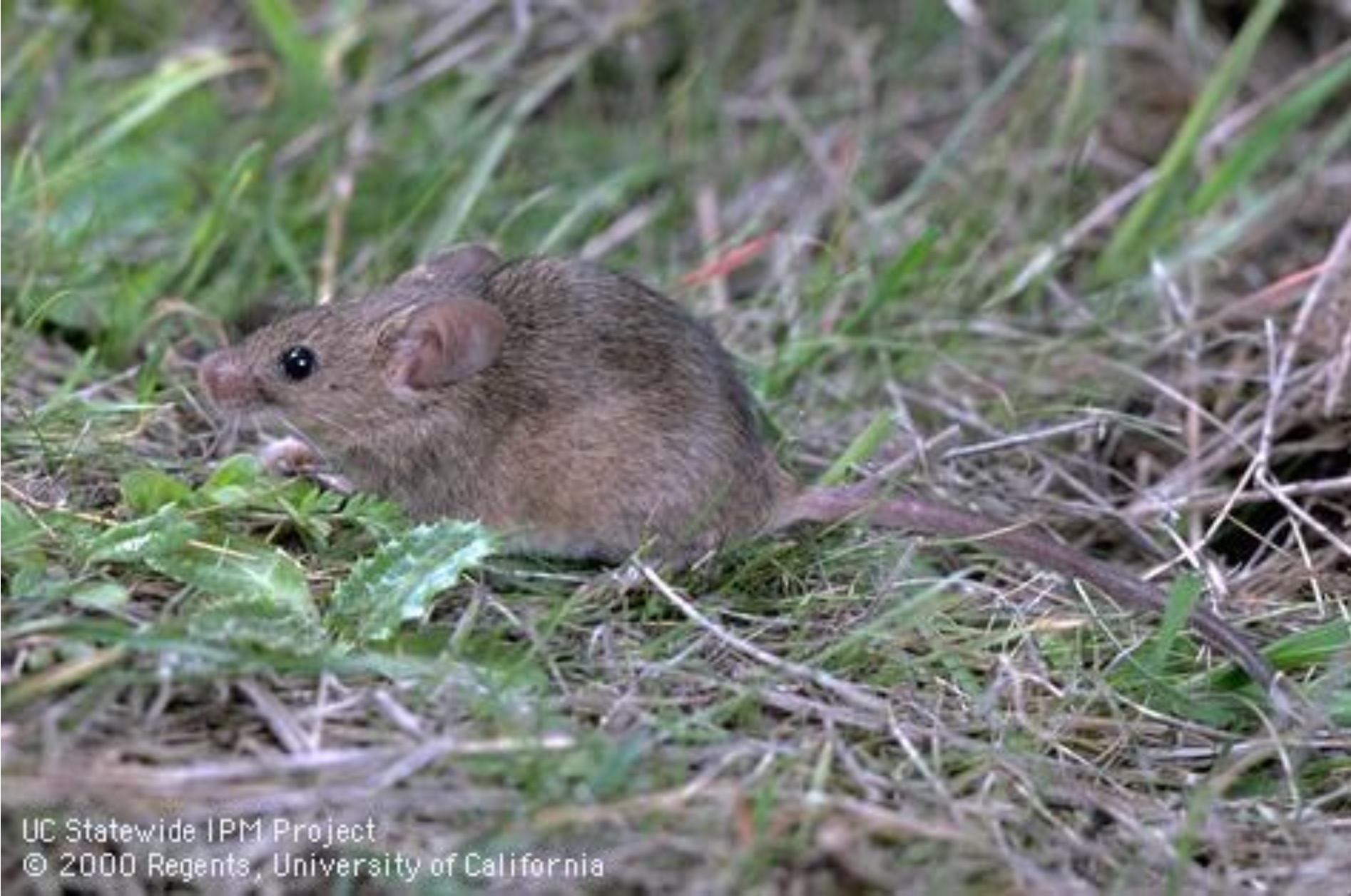 Managing House Mice - January 29, 2020 Jeff Schalau, Agent, Agriculture & Natural Resources University of Arizona Cooperative Extension, Yavapai County The house mouse (Mus musculus) is a common pest in houses and outbuildings. It is well adapted to sharing our living space and resources and has been doing so for thousands of years. These little pests can share other things with us too: like diseases and parasites. This column will explain their life cycle, habits, and preferences in order to help you understand and control them. House mice are much smaller than rats and can be distinguished from a juvenile rat by their smaller feet and head. Their fur is usually a dusty gray above and cream colored on the belly. They can also be identified by their droppings which are 1/8" to 1/4” inch (3 to 6 mm) long and rod-shaped with pointed ends. Other signs of house mice are: gnaw marks on wood, cardboard, and soft plastic; tracks/footprints (4 toes on the front 5 toes on the rear feet); rub marks (dirty areas along base boards and walls); and damaged goods such as cereals and seeds. House mice reach sexual maturity at 35 days old and the female’s gestation period averages 19 days. The young are born blind and hairless (often called pinkies) except for whiskers and are weaned after about 3 to 4 weeks. Average litter size is 6 and each female can bear about 8 litters per year. They usually live for about a year, but have been known to live as long as 6 years. Mice are mainly nocturnal but can sometimes be seen during the day. They have keen senses of smell and hearing but poor eyesight. On a rough surface, they can run up a wall, jump 12” up in the air, and can jump down 8 feet and survive. A mouse requires 1/10 oz. of food per day. Free water is not necessary because they can get it from their food. However, if free water is available, they will drink it. Mice are very social. Related males and females are compatible, but unrelated mice are typically aggressive toward each other. One male dominates the territory over other lower-ranking males. The territory may also include several females and all mature mice tend to show aggression toward strangers within their territory. Mice are very inquisitive. If something has changed position or is out of place, they will explore it and adjust their travel routes accordingly. There are two main feeding periods: at dusk and just before dawn. They will also nibble on small amounts of food anytime. They prefer to nest in dark, secluded places with abundant nesting material close by. The material may be cotton, packing material, insulation, or fabric. Adult mice can also squeeze through an opening 1/4” or larger to gain entry. The most threatening health issue with mice is their ability to spread Salmonella bacteria in their droppings. This organism is a common cause of food poisoning. Other transmittable organisms are tapeworms, rat-bite fever, infectious jaundice/leptospirosis/ Wiel’s Disease, plague, Hantavirus, and possibly poliomyelitis (polio). Given these potentially life threatening diseases, mice should not be tolerated in your living space. To reduce indoor mouse populations, you should start by trying to exclude them and eliminate access to food sources, water and shelter. If this is done and the problem continues, then you should consider population control. The old standby is the snap trap set and placed along a well-traveled wall. I usually bait these traps with peanut butter. Battery-powered electronic traps are available which kill mice by electrocution. Glue boards and sticky traps are also available, but may be considered less humane. Toxicants (poison baits) and anti-coagulant rodenticides can be used as well, but the dead mice may smell badly if they die inside the house. Dead mice should only be handled while wearing disposable rubber gloves or a plastic bag over your hand and placed in an outdoor trash receptacle or buried if you have space to do so. Wash your hands thoroughly with soap and water after disposal The presence of mice in sheds and barns often attracts other predators including snakes, owls, coyotes, bobcats, and foxes. Cats and dogs can also help control mice. This time honored tradition works fairly well, but they don’t need to go hungry to encourage them to hunt. See additional resources below. You can follow the Backyard Gardener on Twitter – use the link on the BYG website. If you have other gardening questions, call or email the Master Gardener help line in the Prescott (928-445-6590/prescottmg@gmail.com) or Camp Verde (928-554-8992/verdevalleymg@gmail.com) and be sure to include your name, address and phone number. Find past Backyard Gardener columns or provide feedback at the Backyard Gardener web site: http://cals.arizona.edu/yavapai/anr/hort/byg/. Images  Adult house mouse (Mus musculus, photo by Jack Kelly Clark, University of California).
Adult house mouse (Mus musculus, photo by Jack Kelly Clark, University of California).Additional Resources House Mouse, University of California IPM ipm.ucanr.edu/PMG/PESTNOTES/pn7483.html Controlling House Mice, University of Nebraska - Lincoln Extension wildlife.unl.edu/pdfs/controlling-house-mice.pdf Should You Worry About House Mice?, Utah State University Extension extension.usu.edu/archive/should-you-worry-about-mice |